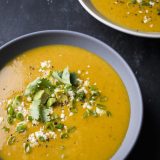Though there are innumerable variations across South America, almost every version of locro de papas shares one trait, says chef Christopher Kese. It is the sort of comfort food you want after a long workday.
“Locro has humble roots using ingredients common to the Andes,” says Kese, who studied cooking in Peru and runs the catering company Lima Peruvian Food in San Francisco. “Now, it’s a comfort food for all levels of society, rich and poor, maybe like mac and cheese is in the U.S.”
Popular all along the Andes Mountains—including in Ecuador and Peru, as well as Argentina and Colombia—locro comes from a Quechuan word for stew. Says Kese: “There are 1,000 different ways to make it, depending on what valley in the Andes you are in.”
Assorted handfuls of herbs are thrown in to finish, and different vegetables are added depending on the season. In Peru, it’s common to add fava beans, choclo (large-kernel corn) or squash. In Argentina, pork may show up. Cheese often is added at the end for a touch of chewy, melty saltiness. If you’re in Peru and feeling particularly hungry, you might slide a poached egg on top.
One thing locro de papas never resembles? The flat, beige blandness that can characterize European-style potato chowders. Also missing are fancy techniques and a muddle of competing flavors.
Color and flavor are key in the Andean versions of potato soup. In Peru, kick may be supplied by ají amarillo, a spicy, fruity chili ubiquitous in Peruvian cooking. In Ecuador, you’ll often find a reddish paste or powder made from ground annatto seeds, known as achiote.
At Milk Street, we used a generous amount of sweet paprika and colorful red and orange bell peppers for fruitiness and color. Cilantro added a sharp contrast of herbal flavor; diced avocado and crumbled queso fresco went in at the end for richness.




